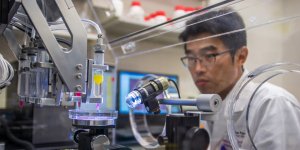Science News
NASA's Nuclear Spectroscopic Telescope Array (NuSTAR) has captured an extreme and rare event in the regions immediately surrounding a supermassive black hole. A compact source of X-rays that sits near the black hole, called the corona, has moved closer to the black hole over a period of just days. »
In the past, many atmospheric scientists believed that pollen particles probably had a negligible effect on climate because they were so big. In recent years, however, as they began to realize that pollen particles were not as sturdy as they once thought, they have been rethinking their old assumptions. »

Researchers developed a lightweight microscope that attaches to a cell phone. The compact fluorescent imaging device can detect single nanoparticles and viruses. It might one day be used to conduct biomedical tests in remote and resource-limited areas. »
Researchers at Ohio University have found the oldest definitive fossil evidence of modern, venomous snakes in Africa. The newly discovered fossil was unearthed in the Rukwa Rift Basin of Tanzania. »
Livestock, particularly horses, have been identified as a significant threat to panda survival. The reason: Horses have been beating pandas to the bamboo buffet. »
The European Space Agency's Rosetta probe is approaching Comet 67P/Churyumov-Gerasimenko for a historic mission to orbit and land on the comet's nucleus. As Rosetta approaches the comet (now less than 9,000 km away), the form of the nucleus is coming into focus, and it is extraordinary. »
For the last 2.5 million years, Earth has experienced millennia-long cold and warm cycles. During cold periods, continental-scale ice sheets have blanketed large tracts of the Northern Hemisphere. »
New research counters a widely-held scientific view that thawing permafrost uniformly accelerates atmospheric warming, indicating instead that certain Arctic lakes store more greenhouse gases than they emit into the atmosphere. »
Some single-celled creatures have structures called motile cilia that beat rhythmically to allow the cells to move. Motile cilia are also found in larger organisms, including people. For example, motile cilia are on cells that line the trachea, where their coordinated wave-like motions carry mucus—along with the inhaled dust, bacteria, and other small particles it contains—toward the mouth to be coughed or sneezed out of the body. »
Emerging fungal pathogens pose a greater threat to biodiversity than any other parasitic group, scientists say, causing population declines of amphibians, bats, corals, bees and snakes. Now, research results reveal that amphibians can acquire behavioral or immunological resistance to a deadly chytrid fungus implicated in global amphibian population declines. »
The solar wind of particles streaming off the sun helps drive flows and swirls in space as complicated as any terrestrial weather pattern. Scientists have now spotted at planet Mercury, for the first time, a classic space weather event called a hot flow anomaly, or HFA, which has previously been spotted at Earth, Venus, Saturn and Mars. »
A newly discovered planet in a binary, or twin, star system located 3,000 light-years from Earth is expanding astronomers' notions of where Earth-like -- and even potentially habitable -- planets can form, and how to find them. »
Scientists have sketched out one of the greatest baby booms in North American history, a centuries-long "growth blip" among southwestern Native Americans between 500 and 1300 A.D. »

While electric vehicles offer many advantages--including reducing greenhouse gas emissions and the country's dependence on imported petroleum--at least one barrier stands in the way of their large-scale adoption: "range anxiety." »
Researchers identified variations in a gene that are associated with lower triglyceride levels and a reduced risk of coronary heart disease. The findings may suggest new directions for development of therapeutics. »

Memories of recent events may be held by a small number of neurons distributed across the brain’s hippocampus, a new study suggests. Understanding how the brain stores memories will yield insights into memory problems that come with normal aging and dementia. »

Less than half the distance between Earth and moon separates Rosetta from its destination, comet 67P/Churyumov-Gerasimenko. The European Space Agency's spacecraft will become the first to orbit a comet and land a probe on its nucleus. »
Researchers discovered a receptor that mosquitoes use to detect both carbon dioxide and skin odor, and they identified compounds that interact with the receptor. The findings may help guide strategies to control mosquitoes and the diseases they transmit. »
NASA scientists have created a new recipe that captures key flavors of the brownish-orange atmosphere around Saturn’s largest moon, Titan. »
The Herschel Space Observatory has uncovered a weird ring of dusty material while obtaining one of the sharpest scans to date of a huge cloud of gas and dust, called NGC 7538. The observations have revealed numerous clumps of material, a baker's dozen of which may evolve into the most powerful kinds of stars in the universe. »
Researchers completed a draft map of the human proteome—the set of all proteins in the human body. The accomplishment will help advance a broad range of research into human health and disease. »
Scientists determined the structure of the intact NMDA receptor, an ion channel involved in many brain-related illnesses including Alzheimer’s disease, depression, schizophrenia, and autism. The finding may aid in the development of future therapies. »
A small dose of low-power laser light activated dental stem cells in rat molars to generate dentin, one of the major components of teeth. The finding may lead to new approaches to develop low-cost, non-invasive therapies for treating dental disease and tooth damage. »
Researchers gained insights into how cells in the auditory system become organized to hear different frequencies. The findings could lead to new approaches for certain kinds of hearing loss. »
Researchers developed a liver-inspired 3-D device made of hydrogel and nanoparticles that can remove toxins from blood. Designed for use outside the body, the device provides a proof-of-concept model for new detoxification techniques. »
A coronal mass ejection, or CME, surged off the side of the sun on May 9, 2014, and NASA's newest solar observatory caught it in extraordinary detail. This was the first CME observed by the Interface Region Imaging Spectrograph, or IRIS, which launched in June 2013 to peer into the lowest levels of the sun's atmosphere with better resolution than ever before. »
Stars that are just beginning to coalesce out of cool swaths of dust and gas are showcased in this image from Spitzer Space Telescope and the Two Micron All Sky Survey. »

Tonight when the new Moon rises, or in the next few nights when the Moon is a slim crescent, go outside and look up. You might see Earth’s reflected light in the dim glow. »
A survey of more than 170,000 supermassive black holes, using NASA's Wide-field Infrared Survey Explorer (WISE), has astronomers reexamining a decades-old theory about the varying appearances of these interstellar objects. »
Scientists have created the first living organism that can grow and reproduce using DNA base pairs that aren’t found in nature. The achievement is a major step toward creating novel therapeutics and nanomaterials. »
People with a variant form of a lifespan-related gene tend not only to live longer but to have better cognitive skills than those who lack the variant, a new study reports. Experiments done in mice might help explain why. The findings could lead to new approaches for improving thinking skills at various life stages. »
Scientists at NASA and the University of California, Irvine, have found that canyons under Greenland's ocean-feeding glaciers are deeper and longer than previously thought, increasing the amount of Greenland's estimated contribution to future sea level rise. »
A new study by researchers at NASA and the University of California, Irvine, finds a rapidly melting section of the West Antarctic Ice Sheet appears to be in an irreversible state of decline, with nothing to stop the glaciers in this area from melting into the sea. »
The largest moon in our solar system, a companion to Jupiter named Ganymede, might have ice and oceans stacked up in several layers like a club sandwich, according to new NASA-funded research that models the moon's makeup. »
Dukono Volcano has been blasting ash above Helmahara Island and the surrounding waters since 2003. On April 28, 2014 the Moderate Resolution Imaging Spectroradiometer (MODIS) on the Terra satellite captured this natural-color view of the erupting volcano. »
As it celebrated its 41st anniversary Thursday (Apr. 24), the Brazilian Agricultural Research Corporation (Embrapa) unveiled the largest genetic repository in Latin America, which can store up to 750,000 seed samples. »
NASA's Wide-field Infrared Survey Explorer and Spitzer Space Telescope have discovered what appears to be the coldest "brown dwarf" known -- a dim, star-like body that surprisingly is as frosty as Earth's North Pole. »
Humans can distinguish more than 1 trillion scents, according to new research. The findings show that our sense of smell is far more discriminating than previously thought. »
Our memory reflects our last retrieval of it rather than an exact account of the original event. When long-term memories are recalled, they become fragile and changeable. New proteins must be produced to reconsolidate retrieved memories and return them to long-term storage in the brain. »
After alcohol is consumed, it is first metabolized, or broken down, into acetaldehyde, a toxic chemical that causes DNA damage. About 40 percent of the East Asian population, and many people of East Asian descent throughout the world, carry a genetic mutation that produces an inactive form of Aldehyde dehydrogenase 2 (ALDH2), the main enzyme responsible for breaking down acetaldehyde into acetate, a nontoxic metabolite in the body. »
Frustration and economic uncertainty related to the start of the worldwide crisis may have had unexpected results. In 2007-2008, the population growth rate of the Czech Republic almost tripled, that of the Netherlands doubled, and the Swiss and the French rates showed solid increases. When the crisis got deeper the trend changed in some countries but population growth remained solid in others. »


